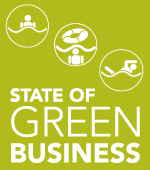Greener Transport Makes Its Move
<p>Although 2010 will likely be remembered as the year of the rebirth of the electric car, green shipping innovations took place also on the land, in the sea and in the air throughout last year.</p>

The year 2010 will likely be remembered for the rebirth of electric vehicles -- not just the vaunted Chevy Volt and Nissan Leaf, and not even the pricey Tesla, but dozens of other brands, large and small, that came into public view. And their entrance has spurred a small but growing ecosystem of corporate alliances seeking to tap into the new opportunities.
Some of these alliances are predictable -- for example, announcements by Hertz and Enterprise to add EVs to their rental fleets. Others brought together large players with smaller ones -- a partnership by Better Place and GE to build a battery recharging infrastructure, for example, or Panasonic's investment in Tesla, allowing the former to supply lithium-ion batteries to the latter, while jointly they work on next-gen battery cells. Meanwhile, a global alliance chaired by Prince Albert of Monaco set a target of getting 1 million more electric vehicles on the road in the next five years than automakers have planned to bring to market. These companies and public agencies join with other early adopters, such as GE, which pledged to buy 25,000 electric vehicles over the next five years for its own fleet, as well as for customers in its fleet management business.
But the greening of transport goes well beyond vehicles. Greener technologies and practices are emerging for a raft of transportation types on land, sea, and air.
Ocean-going vessels, the means by which twothirds of the goods purchased by U.S. consumers arrive on American shores, have long been an environmental problem. While ocean-going vessels worldwide account for just 2 to 3 percent of global fossil-fuel consumption, they are responsible for 14 percent of the nitrogen emissions from fossil fuels and 16 percent of all sulfur emissions from petroleum, according to a study by Carnegie Mellon University. One reason: Cargo ships run on "bunker fuel," the dirtiest, cheapest product that remains once gas and other high-grade fuels have been refined from crude oil.
Shippers traditionally have had no visibility into which companies are using cleaner fuels, but that's changing. Last year, Maersk Line became the first in its industry to independently verify its carbon emissions vessel by vessel, enabling customers to track the environmental data along with other performance information about the shipping line. The company also said it was slowing down its ships to save fuel and cut emissions. It found that a 20 percent reduction in speed can cut fuel use and CO2 emissions by up to 40 percent. Meanwhile, the world's first hybrid electric tugboat, which plies Southern California's San Pedro Bay, emits 73 percent less soot, 51 percent fewer nitrogen oxides and 27 percent less carbon dioxide than a standard tug of comparable size, researchers found. Talk about a sea change.
Up in the air, carriers found new ways to cut fuel and emissions. Alaska Airlines began tests of a new emissions-reducing technology, winging its way to 35 percent reductions by reconfiguring how its planes descend for landing. Its "Optimized Profile Descents" allow jets to idle their engines for more of the descent, saving nearly 60 gallons of fuel per flight. Virgin America said that it would cut fuel use by up to 3 percent this year simply because of better routing.
Back on terra firma, the biggest shipping companies revved up their competition to cut fuel use and emissions. FedEx Corp. developed a new program to unify the company's efforts to meet its goals of minimizing its environmental impact. Its EarthSmart program is aimed at inspiring innovations that will help the company improve vehicle fuel efficiency by 20 percent by 2020. United Parcel Service, for its part, expanded its carbon-neutral shipping program to 35 countries. Under the program, shippers in the U.S. can offset the carbon footprint of their packages by paying a small fee that covers the cost of the offsets, emissions calculation, and administration.
Even railroads seemed to be moving down the right track, environmentally speaking. U.S. rail operator Amtrak may have given the term "cattle car" a new meaning with the first test of a biodiesel train that runs on beef byproducts. The government-owned rail company began operating its daily Heartland Flyer traveling between Oklahoma City and Forth Worth using B20 biodiesel fuel. The fuel, which mixes 80 percent diesel with 20 percent biofuel, cuts both hydrocarbon and carbon monoxide emissions by 10 percent.
Photo CC-licensed by SoulRider.222.






